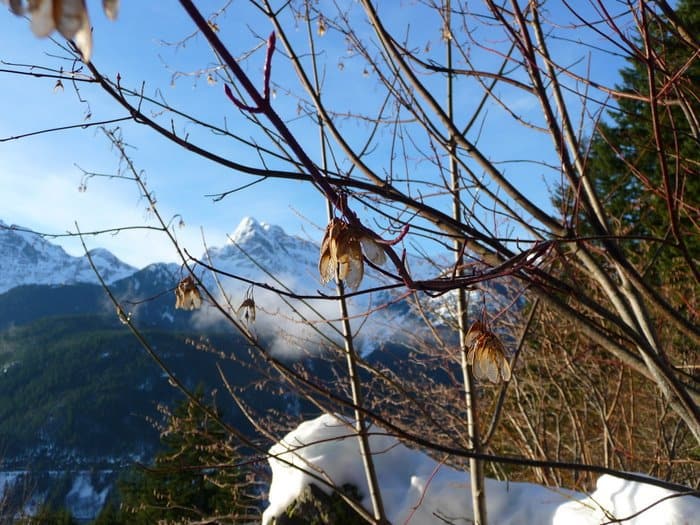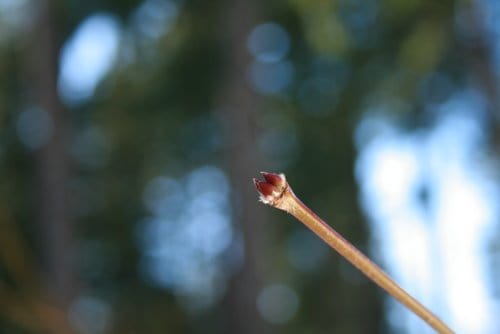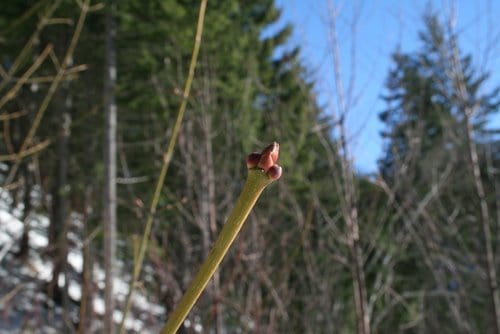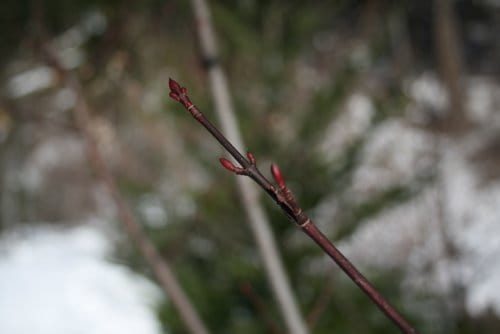Twig tracking
 I’ve recently taken up a new hobby, I like to call it twig tracking.
I’ve recently taken up a new hobby, I like to call it twig tracking.
I started twig tracking to feel more connected, to feel at home in all seasons. Twig tracking is just a fancy name for native plant identification through the cold winter months. It sounds a lot more exciting if you call it twig tracking.
This new hobby, distinguishing trees and shrubs in all seasons, has caused me to shift my perception. Rather than seeing a dreary landscape of brown sticks I see deep reds, grey-green hues, oranges, yellows and chestnut browns. I see interesting shapes and intricate designs. I now recognize plants by the form and placement of the developing buds, the structure of the branches, remnant fruits and new catkins, and the texture of the branches.
I was twig tracking recently when I discovered a new tree. I’d walked by this point countless times, in all seasons, and never noticed this particular tree, what was it? The overall shape of the tree resembled a Vine maple but the buds and winged fruits weren’t right. There were small lenticels and the bark was somewhat reminiscent of a Red alder, but different. After close examination, measurements, considerable speculation and a significant amount of time spent with various guide books I realized it was a Douglas maple. A new species for me! What an exciting discovery. I didn’t know we had Douglas maple on campus. The funny thing is, now I am seeing Douglas maples everywhere.
So next time you are out, wandering in this wintry landscape, stop and look at the trees and shrubs. Note the color, shape, texture, and size of the buds. Examine the branches, are there lenticels? What shape are they, are they raised? What is the texture of the bark, is it peeling or smooth? What color is it: brown, red or green? All of the clues can help you identify the tree in question. Who knows, maybe you too will take up twig tracking.
 (Top) Pyramid Peak framed with Douglas maple branches. (Above) A Vine maple bud. Note the fine hairs,the deep burgundy color and that the buds are a pair.
(Top) Pyramid Peak framed with Douglas maple branches. (Above) A Vine maple bud. Note the fine hairs,the deep burgundy color and that the buds are a pair.
 A Big leaf maple bud. These buds are large, ~1/2″, and rounded.
A Big leaf maple bud. These buds are large, ~1/2″, and rounded.
 Douglas maple buds. Note the burgundy, oval shaped terminal bud with two smaller lateral buds. If the winged fruits are present they are V-shaped and tan in color.
Douglas maple buds. Note the burgundy, oval shaped terminal bud with two smaller lateral buds. If the winged fruits are present they are V-shaped and tan in color.
Useful links:
Burke Museum of Natural History and Culture: University of Washington Herbarium
Washington Native Plant Society


Jenny, this is great — three of my favorite trees, exposed in all their winter glory. There is something about maples in all seasons that I find calming — maybe it’s because I grew up in a deciduous environment (Ohio), maybe because they were some of the first trees I learned to ID as a kid, or maybe it’s something about maple syrup (Ohio, again). Anyway, thanks for the reminder about looking closely when we think we know what’s in front of our noses. Twig tracks indeed!
Cool! Do you know of any good books about this?
In 1951 I took a dendrology course at UMass Amherst, that featured winter ID of shrubs and trees. We used a book called Keys to Woody Plants by Muenscher of Cornell U. Comstock Publ. Co 1950.It is just a curiosity now, but I doubt that the twigs and buds have changed much. It must have been effective: I remember stuff in it after 58 years, 49 of them spent in the West – out of the book’s range. Maybe there is something like it for Cascadia.
I do this too, but didn’t have a name for it. I’m always anxious for spring, and this time of year the buds start changing. You can see the hazel catkins emerge and the cottonwood buds swell and get fragrant.
Watch for the Douglas maple flowers when they come out. They’re quite different from vine maple: bright yellow-green and shaped like Flower Power flowers from the 60s.
Thanks for the name of a favorite activity!
This is great, Jenny. We had a visitor at the ELC this fall who pursued a career in medicine, but who had a masters in dendrology, and had studied under one of the greats in the field. She was interested in a winter (or very early spring?) program that would explore North Cascades flora and fauna in their winter mode. Sounds like a great idea!
Jenny, this is a favorite hobby of mine as well, thank you for giving it a great name.